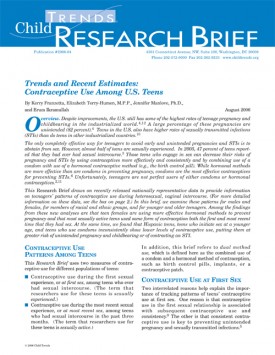Trends and Recent Estimates of Contraceptive Use Among U.S. Teens
Resource type: Research Report
Child Trends |
In the U.S., teen females are using more effective hormonal and barrier methods to prevent pregnancy. At the same time, Hispanic teens initiate sex at a younger age and show lower levels of contraceptive use, putting them at greater risk of unintended pregnancy and childbearing or of contracting a sexually transmitted disease, according to this research brief by Child Trends. Child Trends is a grantee of The Atlantic Philanthropies.
Summary:
Child Trends, an Atlantic grantee, examines contraceptive use trends among teens in the United States using data from the 2002 National Survey of Family Growth, which was conducted by the National Center for Health Statistics and supplemented with original analyses by Child Trends.
Child Trends’ study reports that contraceptive use at both first and most recent sex varies by race and ethnicity. The findings for Hispanic teen girls are still a concern. Among teen females, in 2002, Hispanics were less likely to use contraception at both first and last sex (36 percent) than non-Hispanic blacks (57 percent) or non-Hispanic whites (72 percent). Among teen males, Hispanics were less likely than whites (65 percent vs. 84 percent) to use contraception at both first and last sex. Hispanic teen males did report similar levels of use at both first and last sex as blacks (77 percent).
Findings also indicate that, in addition to the birth control pill, sexually experienced teen females, both married and unmarried, are using other highly effective hormonal methods of contraception. The proportion of female teens who had used an injectable method of contraception, such as Depo-Provera™, more than doubled between 1995 and 2002, from 10 percent to 21 percent.
